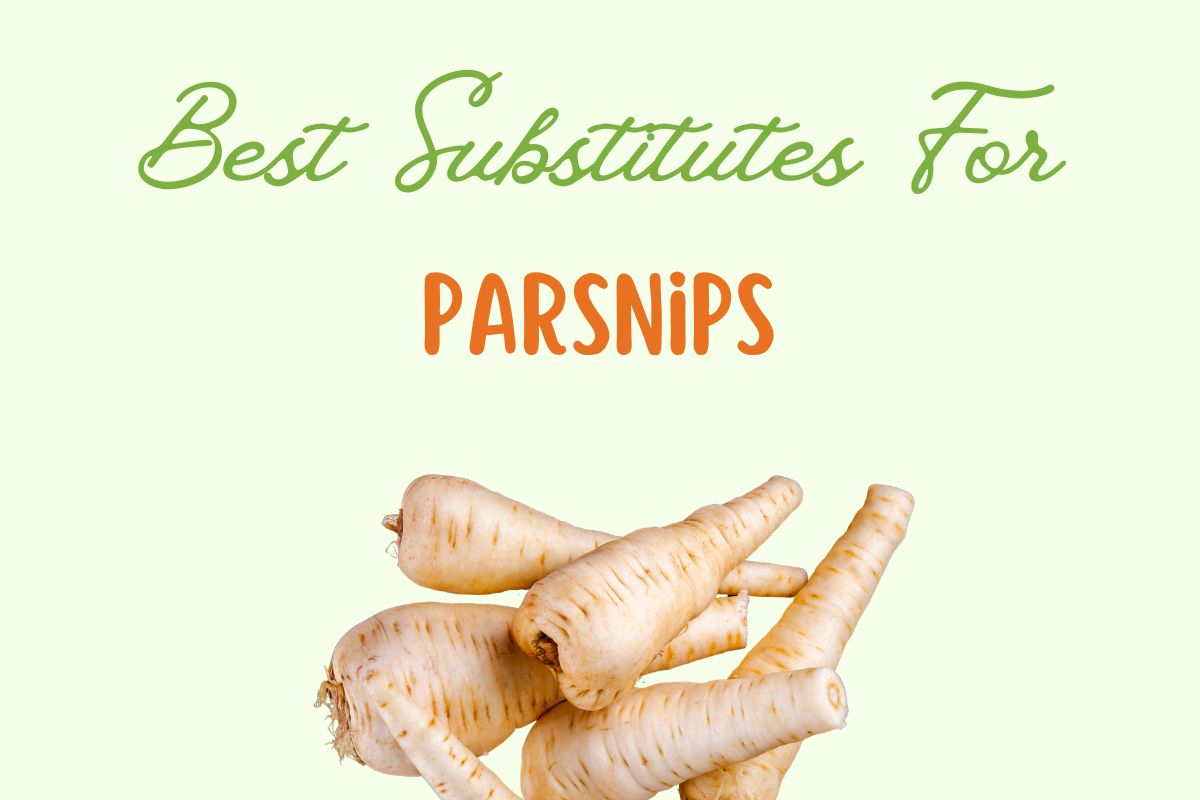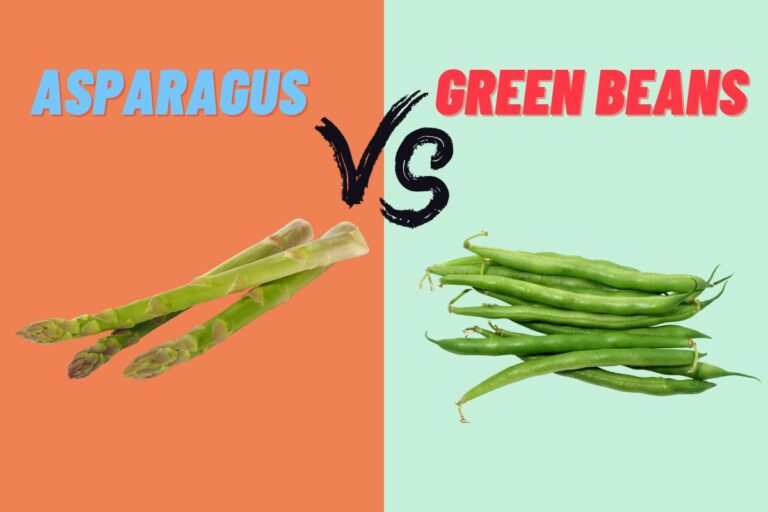5 Best Substitutes For Parsnips
Are you looking for tasty alternatives to parsnips in your recipes? Look no further! We’ve got you covered with a list of the best substitutes for parsnips. Did you know that white carrots closely resemble parsnips both in appearance and flavor? In this blog post, we’ll explore different root vegetables that can be used as replacements for parsnips, providing practical tips and delicious recipes along the way. Get ready to elevate your culinary adventures with these amazing alternatives to parsnips!
Understanding Parsnips: A Brief Overview
Parsnips, a versatile root vegetable, hold an esteemed spot in the culinary world. They take on a slight sweetness when cooked and offer a unique flavor that’s slightly nutty and earthy.
Integral to various cuisines worldwide, parsnips are quite similar in appearance to white carrots and parsley roots. Apart from their diverse use in recipes such as soups, stews, roasted dishes, and purees; these vegetables present impressive nutritional benefits too – packing vitamins C & K along with essential minerals like manganese and potassium.
Yet despite their availability year-round – specifically harvested late fall through winter – the need for substitutes can arise due to personal preferences or dietary restrictions.
From using sweet potatoes as a deliciously distinct replacement for parsnips or turnips for their robust alternative taste profile – The substitutes abound!
Why might you need a substitute for Parsnips?
There are several reasons you might need a substitute for parsnips in your cooking. You could be out of this root vegetable and need an alternative to complete your recipe, or perhaps you’re catering to someone who doesn’t enjoy the distinct taste of parsnips.
In some cases, dietary restrictions may require replacing this veggie with another option. For instance, white carrots share a similar appearance and flavor profile with the parsnip but offer slight variations that can cater to specific needs.
Parsley root is also highly recommended as it mirrors not just the look but also texture of parsnips. The quest for variety or novel culinary experiences could prompt seeking other root vegetables like turnips and celery roots as great alternatives too!
Understanding Flavour Profiles: What does a Parsnip Taste Like?
Parsnips have a unique taste that is slightly sweet with a hint of earthiness. The texture is smooth and creamy when cooked, while the aroma is reminiscent of carrots and celery. Discover more about parsnip’s flavor profile to find the best substitutes for your recipes!
The Unique Taste of Parsnips
Parsnips have a unique taste that sets them apart from other root vegetables. They have a slightly sweet and nutty flavor with earthy undertones, making them a delicious addition to various dishes.
The texture of parsnips is also distinctive, as they are tender yet firm when cooked. When roasted or sautéed, parsnips develop a rich golden color and caramelized edges, enhancing their flavor even more.
Their aroma is warm and aromatic, adding depth to any recipe they are used in. These qualities make parsnips a sought-after ingredient for those who enjoy exploring different flavors and textures in their cooking.
Texture and Aroma of Parsnips
The texture of parsnips is often described as creamy and tender. When cooked, they have a soft and velvety consistency that adds a delightful element to various dishes. Additionally, parsnips have a distinct aroma that can be described as earthy, sweet, and slightly nutty.
This unique combination of texture and aroma makes parsnips stand out in the culinary world and contributes to their popularity in different cuisines. Whether you’re roasting them for added crispness or incorporating them into soups for a comforting flavor, the texture and aroma of parsnips are sure to enhance any dish.
1. Carrots: The Top Contender
– Carrots make an excellent substitute for parsnips due to their similar taste and texture. Discover how to use carrots as a parsnip substitute and try out some delicious recipes! Read more to find out why carrots are the top contender for replacing parsnips in your cooking adventures.
Why Carrots Make an Excellent Substitute
Carrots make an excellent substitute for parsnips due to their similar flavor and texture. Both vegetables belong to the same family, Apiaceae, which is why they share certain characteristics.
Carrots have a slightly sweeter taste compared to parsnips but can still provide that earthy and nutty flavor that is characteristic of parsnips. They also have a similar appearance, with their long and tapered shape, making them visually appealing substitutes in dishes.
Whether roasted, sautéed, or used in soups and stews, carrots can seamlessly replace parsnips while adding a touch of sweetness to your culinary creations.
How to Use Carrots as a Parsnip Substitute
Carrots are an excellent substitute for parsnips in cooking. Here’s how you can use carrots as a parsnip substitute:
- Start by selecting fresh and firm carrots that are similar in size to the parsnips called for in your recipe.
- Peel the carrots to remove the outer skin, just like you would with parsnips.
- Cut the carrots into similar shapes and sizes as the parsnips in your recipe. This will ensure even cooking and consistent texture.
- Use the carrots in place of parsnips in your favorite recipes. Carrots can be roasted, boiled, mashed, or used in soups and stews just like parsnips.
- Keep in mind that carrots have a slightly sweeter flavor compared to parsnips, so adjust other seasonings accordingly to balance out the taste.
- Enjoy the delicious carrot – infused dishes as a great alternative to using parsnips.
2. Turnips: A Robust Alternative
– Turnips can be used as a replacement for parsnips in cooking, offering a robust and slightly peppery flavor that adds depth to your dishes. So, if you’re looking for an alternative to parsnips, read on to learn more about using turnips in your recipes.
Understanding the Flavour Profile of Turnips
Turnips have a distinct and robust flavor profile that can make them an excellent substitute for parsnips. They have a slightly peppery taste with earthy undertones, giving dishes a rich and satisfying flavor.
Turnips also offer a crisp and crunchy texture, making them versatile in various cooking methods. Whether you’re roasting or sautéing them, turnips bring their unique personality to the table, adding depth and complexity to your recipes.
So if you’re looking for an unconventional replacement for parsnips, give turnips a try and explore the delightful flavors they bring to your culinary adventures.
Using Turnips as a Parsnip Substitute
Turnips can be a versatile and flavorful substitute for parsnips in cooking. Here are a few ways you can use turnips as a replacement:
- Roasted Turnip Fries: Slice the turnips into thin wedges, toss them with olive oil, salt, and your favorite spices, then roast them in the oven until they’re crispy and golden.
- Mashed Turnips: Boil diced turnips until they’re tender, then mash them with butter, salt, and pepper for a creamy side dish that pairs well with roasted meats.
- Turnip Puree: Steam or boil the turnips until they’re soft, then blend them in a food processor or blender until smooth. Use this puree as a base for soups or sauces to add depth of flavor.
- Turnip Gratin: Layer thinly sliced turnips with cream, cheese, and herbs in a baking dish. Bake until bubbly and golden brown for a delicious and comforting side dish.
3. Sweet Potatoes: A Sweet Spin
– Sweet potatoes can be a suitable replacement for parsnips in your recipes, adding a subtly sweet flavor to your dishes. Discover how to incorporate them into your cooking and take your culinary creations to the next level.
Read on for more!
Why Choose Sweet Potatoes?
Sweet potatoes are an excellent choice as a substitute for parsnips due to their similar texture and slightly sweet flavor. They can be easily roasted, mashed, or used in soups and stews as a replacement for parsnips.
Sweet potatoes are also rich in vitamins, minerals, and fiber, making them a nutritious option to incorporate into your recipes. Whether you’re looking to add a touch of sweetness or simply want to try something different, sweet potatoes offer a delicious twist on traditional parsnip dishes.
Cooking with Sweet Potatoes Instead of Parsnips
Sweet potatoes can be a great substitute for parsnips in various recipes. Here are some ideas on how to use sweet potatoes as a replacement:
- Mashed Sweet Potatoes: Just like mashed parsnips, you can peel and boil sweet potatoes until they are soft enough to mash. Add butter, salt, and any other seasonings you prefer for a delicious side dish.
- Roasted Sweet Potatoes: Cut sweet potatoes into cubes or wedges, toss them with olive oil, salt, and your choice of herbs or spices. Roast them in the oven until they are crispy on the outside and tender on the inside.
- Sweet Potato Fries: Slice sweet potatoes into thin strips and coat them with a mixture of flour or cornstarch, salt, and spices. Then bake or fry them until they are golden brown and crispy.
- Sweet Potato Soup: Replace parsnips with sweet potatoes in your favorite soup recipe. Cook the sweet potatoes until they are tender, then blend them with broth and seasonings for a creamy and comforting soup.
- Sweet Potato Casserole: Instead of using parsnips in your casserole dish, top it with mashed sweet potatoes mixed with butter, brown sugar, cinnamon, and pecans for a deliciously sweet twist on a classic recipe.
4. Rutabagas: The Unconventional Replacement
– Unveiling Rutabagas: Discover the unique flavor and versatility of rutabagas as a substitute for parsnips. Don’t miss out on this unconventional yet delicious replacement option.
Unveiling Rutabagas
Rutabagas, also known as swedes or yellow turnips, are an unconventional but excellent replacement for parsnips in your cooking. These root vegetables may not be as commonly used, but they offer a unique flavor and texture that can add depth to your dishes.
Rutabagas have a slightly sweet and peppery taste with a hint of bitterness, making them an interesting substitute for parsnips. They also have a firm texture that holds up well when cooked, whether roasted, mashed, or added to soups and stews.
Don’t overlook rutabagas the next time you’re looking for a substitute for parsnips – they just might become your new favorite ingredient in the kitchen!
Preparing Rutabagas as a Substitute for Parsnips
Rutabagas, also known as swedes or yellow turnips, can be a flavorful and nutritious alternative to parsnips in your recipes. Here’s how to prepare rutabagas as a substitute for parsnips:
- Choose fresh rutabagas: Look for firm and heavy rutabagas with smooth skin. Avoid any that have soft spots or blemishes.
- Peel and chop the rutabagas: Start by peeling the outer skin of the rutabagas using a vegetable peeler or a knife. Then, chop them into cubes or slices, depending on your recipe.
- Boil or steam the rutabagas: Place the chopped rutabagas in a pot of boiling water or steam them until they become tender. This process usually takes around 15-20 minutes.
- Season to taste: Once the rutabagas are cooked, drain them and season with salt, pepper, and any other desired spices or herbs. You can also add butter or olive oil for extra flavor.
- Use in your recipe: Now that your rutabagas are prepared, you can use them just like you would use parsnips in various dishes such as soups, stews, roasts, or mashes.
5. Celeriac: An Underrated Choice
– Celeriac offers a unique taste that makes it an excellent substitute for parsnips in your recipes. Discover the versatility of this underrated choice and how to use it effectively as a replacement.
Read on to find out more!
The Unique Taste of Celeriac
Celeriac, also known as celery root, offers a unique taste that can make it a suitable substitute for parsnips in various recipes. This root vegetable has a mild and slightly nutty flavor with hints of celery.
Its texture is crisp and firm when raw, but becomes creamy and tender when cooked. Celeriac adds a depth of flavor to dishes and pairs well with other ingredients like potatoes or carrots.
It can be used in soups, roasted dishes, or even mashed as an alternative to parsnips for those looking to add a distinct taste to their culinary creations.
Substituting Parsnips with Celeriac in Your Recipes
Celeriac, also known as celery root, is an excellent substitute for parsnips in your recipes. Its unique taste and texture make it a great alternative to add depth of flavor to your dishes. Here are some ways you can use celeriac as a substitute for parsnips:
- Mashed Potatoes: Replace part or all of the parsnips in your mashed potato recipe with celeriac. It will add a subtle celery-like flavor and creamy texture to the dish.
- Roasted Vegetables: Cut celeriac into cubes and roast them alongside other root vegetables like carrots and potatoes. The caramelized edges of the roasted celeriac will bring a delicious earthiness to the dish.
- Soups and Stews: Add diced celeriac to your soups or stews to enhance the flavor profile. It pairs well with other vegetables like carrots, onions, and potatoes.
- Gratins: Layer thinly sliced celeriac in a gratin dish along with other vegetables like potatoes or sweet potatoes. The celeriac will provide a unique flavor twist to the classic dish.
- Salads: Shave raw celeriac into thin strips and toss it into salads for added crunch and flavor. Its slightly nutty taste pairs well with citrus dressings or creamy mayonnaise-based dressings.
Comparing the Substitutes: comparison table
Comparing the various substitutes for parsnips will help you decide which to use based on your personal preference and the specific recipe you’re making. Here’s a comparison table to help you make your decision.
| Substitute | Appearance | Taste | Best Used In |
| White Carrots | Similar to parsnips in appearance | Similar flavor to parsnips | Can be used in all dishes requiring parsnips |
| Parsley Root | Resembles parsnips in look and texture | Slightly spicier than parsnips | Great in soups and stews |
| Turnips | Different in color but similar texture | Robust flavor, slightly tangy | Suitable for roasting and mashing |
| Celery Root (Celeriac) | Knobby and rough in appearance | Earthy flavor with a hint of celery | Good for soups, stews, and roasting |
| Sweet Potatoes | Distinctively orange in color | Sweet and rich flavor | Great for roasting, baking, and mashing |
| Salsify | Long, thin, and tan | Slightly sweet with a hint of oyster flavor | Ideal for soups and stews |
| Rutabagas | Large, round, and purple or yellowish | Sweet, nutty flavor | Perfect for roasting and mashing |
| Potatoes | Varies greatly depending on type | Starchy and mildly sweet | Can substitute parsnips in many recipes |
Cooking with Parsnip Substitutes
Cooking with parsnip substitutes opens up a world of delicious possibilities. Whether you’re making soups, roasting vegetables, or creating hearty stews, there are plenty of options to explore.
Carrots make an excellent substitute for parsnips due to their similar flavor and texture. Simply swap out the parsnips for carrots in your recipes, and you’ll achieve a similar taste profile.
Sweet potatoes also offer a sweet spin on traditional parsnip dishes, adding a unique flavor and vibrant color to your meals. Turnips can provide a robust alternative as well, bringing their own distinct flavor to the table.
And don’t forget about celeriac – an underrated choice that offers its own unique taste when substituting for parsnips in your favorite recipes. So go ahead and embrace variety in your culinary adventure by experimenting with these tasty parsnip alternatives!
Soup Recipes Using Parsnip Substitutes
- Carrot and Ginger Soup: Start by sautéing onions in olive oil, then add chopped carrots and fresh ginger. Cook until the carrots are tender, then blend until smooth. Season with salt and pepper to taste.
- Turnip and Potato Soup: In a pot, combine diced turnips, potatoes, onions, and garlic with vegetable broth. Simmer until the vegetables are soft, then blend until creamy. Add herbs like thyme or rosemary for extra flavor.
- Sweet Potato and Coconut Soup: Roast sweet potatoes until tender, then blend them with coconut milk, vegetable broth, and spices like cumin and curry powder. Garnish with coconut flakes or cilantro.
- Rutabaga and Leek Soup: Sauté sliced leeks in butter until softened, then add cubed rutabaga and vegetable broth. Cook until the rutabaga is tender, then puree the soup until smooth. Sprinkle with fresh parsley before serving.
- Celeriac and Apple Soup: Sauté chopped celeriac and apples in butter until they start to soften. Add vegetable broth and simmer until the celeriac is cooked through. Blend until smooth and season with salt, pepper, and a touch of nutmeg.
- Parsley Root Bisque: Sauté finely chopped parsley root in olive oil with onions until they are translucent. Add vegetable broth and simmer for around 20 minutes. Puree the mixture in a blender or food processor until creamy.
- Kohlrabi Chowder: Cook diced kohlrabi in a pot with onion, garlic, vegetable broth, and cream (or a non-dairy alternative). Once the kohlrabi is tender, use an immersion blender to partially blend the soup for a chunky texture.
- Radish Miso Soup: Combine thinly sliced radishes with miso paste dissolved in vegetable broth. Bring the mixture to a simmer, then garnish with green onions and seaweed for an Asian-inspired twist.
- Jicama and Lime Soup: Sauté jicama in butter with garlic until it softens. Add vegetable broth, lime juice, and bring to a boil. Blend until creamy and season with salt, pepper, and fresh cilantro.
- Parsnip Substitute Minestrone: Use any combination of the above substitute ingredients along with other vegetables like celery, tomatoes, beans, and pasta or rice to create a hearty minestrone soup.
Remember to experiment with these recipes by adding your favorite herbs, spices, or toppings to customize the flavors according to your taste preferences. Enjoy exploring different substitutes for parsnips in these delicious soup recipes!
Roasting Recipes Using Parsnip Substitutes
- Roasted Carrots: Slice carrots into long, thin strips and toss them with olive oil, salt, and your favorite herbs and spices. Roast them in the oven at 400°F (200°C) for about 25-30 minutes until they are tender and caramelized.
- Turnip Fries: Cut turnips into thin fry shapes and coat them with olive oil, salt, and pepper. Spread them out on a baking sheet and roast at 425°F (220°C) for approximately 20-25 minutes until they become crispy and golden brown.
- Roasted Sweet Potatoes: Peel and cube sweet potatoes into bite-sized pieces. Toss them with olive oil, smoked paprika, garlic powder, salt, and pepper. Roast at 425°F (220°C) for 25-30 minutes or until they are soft on the inside with a slightly crispy exterior.
- Rutabaga Wedges: Peel rutabagas and cut them into wedges. Drizzle with olive oil, sprinkle with thyme or rosemary, salt, and pepper. Roast in the oven at 400°F (200°C) for about 30-35 minutes until they are tender when pierced with a fork.
- Celeriac Hash Browns: Grate celeriac into fine shreds using a box grater or food processor. Squeeze out any excess moisture using a kitchen towel. Season with salt and pepper before shaping them into small patties. Heat olive oil in a skillet over medium heat and cook the hash browns for about 4-5 minutes on each side until golden brown.
Remember to adjust cooking times based on the size of your vegetable pieces to ensure they cook evenly throughout. Enjoy these roasted parsnip substitutes as flavorful sides or incorporate them creatively into your dishes!
Conclusion
In conclusion, when it comes to finding the best substitutes for parsnips, there are several options to choose from. Carrots make an excellent choice with their similar taste and texture, while turnips offer a robust alternative.
Sweet potatoes provide a unique and sweet spin, and rutabagas offer an unconventional replacement for parsnips. Celeriac is an underrated choice that brings its own unique flavor to dishes.
Embracing these substitutes allows you to add variety and creativity to your culinary adventures without compromising on taste or quality.




